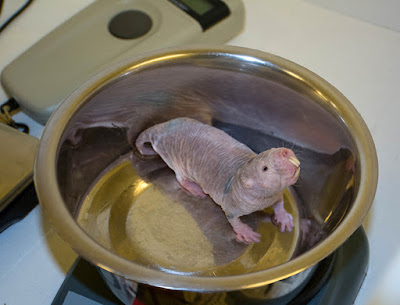Since the arrival of six naked mole rats to Pacific Science Center from the Philadelphia Zoological Gardens in 1993, we have tried a variety of methods to identify each individual. Perhaps we have finally found a solution!
Taking care of eusocial animals means taking care of an entire group; not just individuals. Twenty-three years ago we primarily focused on the colony health and total number of naked mole rats. Over time we wanted more information and began to collect records on the individual animals.
Mole rats are not easy animals to identify individually. Unlike animals with anatomical features that can be marked and tagged, naked mole rats have internal ears and sensitive tails. A leg band could simply be chewed off.
In 2001, we first attempted to identify individual naked mole rats by implanting microchips. At that time, microchips were much larger than today’s implants. The few individuals whom we did microchip had significant issues with healing and infection after the procedure. Over time, they recovered and eight of those original few are still in our colony. That experience soured us on microchips for a long time.
Our next tactic was significantly lower tech: Sharpie markers. Animal Care used a combination of colors and ink placement on the mole rats’ skin. However, the ink had to be refreshed monthly as the marks easily faded from the animals’ thin and stretchy skin. After five years, we searched for a more permanent method to identify the naked mole rats.
In September 2011, we had the colony tattooed. We were very hopeful about this technique, but unfortunately tattoos were not a magical solution. The mole rats’ skin is so thin that the subcutaneous ink bled and the markings ran together. Furthermore, we had a large number of mole rats that were too young to be tattooed at that time. They have never been marked.
Back to the drawing board and back to the conversation about microchips. In the past 15 years, technology has produced an implantable microchip that is a fraction of the size of the old ones. But we were still cautious.
In October, our veterinarian Dr. Maas implanted microchips in three of the unmarked naked mole rats as a test. Noting their success, we next had a group of 24 chipped. All seem to be thriving.
Recently Dr. Maas completed the multistage chipping of our naked mole rat colony and now the members of the colony can easily be scanned and identified as they are checked for weight and health.
The next time we perform a mole rat health check we won’t have to squint and ask each other, “Was that one dot or two?” The future has arrived!
Friday, February 5, 2016
Subscribe to:
Post Comments (Atom)









Too Cool!
ReplyDelete